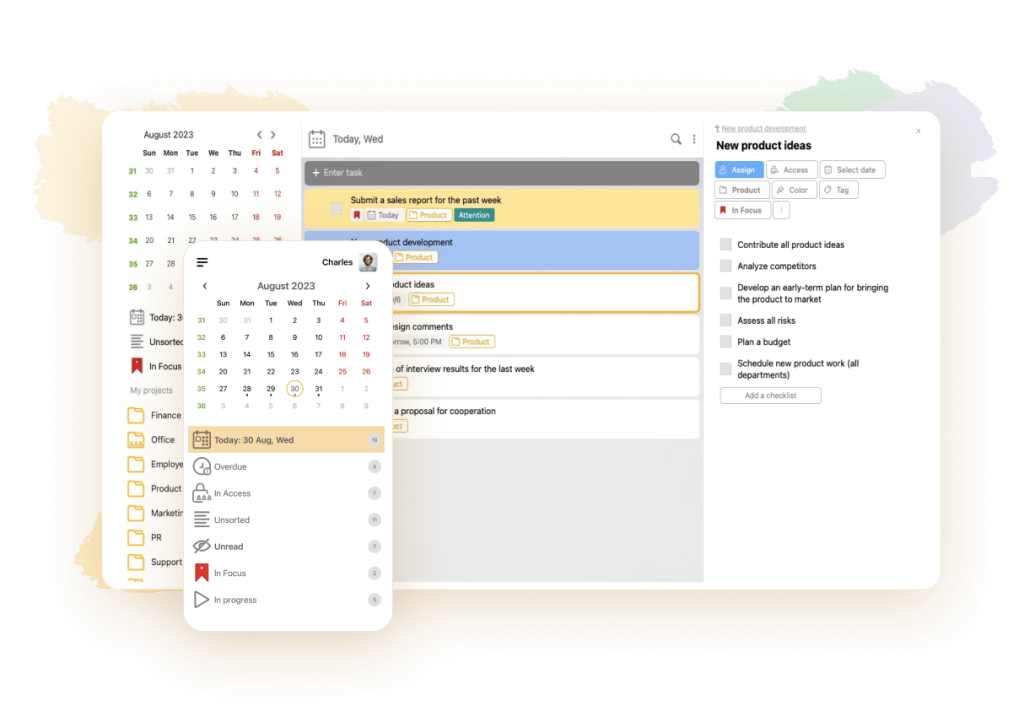Project goals and objectives

The first step in developing any project is proper goal setting. This action determines what result the team wants to achieve. Goal setting creates an image of the desired future. Project goals answer the question, “What should the team get at the end of the project?” Each goal has a set of objectives: actions to be performed to achieve the planned result. Their formulation starts with an action verb: to develop, to do, to conduct, to organize, and so on. This will make them measurable and controllable.
When referring to the concepts of “project goals and objectives”, we often identify them as synonyms. But, in fact, these are different categories in meaning and content, which require separate analysis and study. How do they differ from each other? How to learn how to formulate and control them correctly? Let us consider these and other questions in more detail.
How project goals and objectives differ
In project management, a project goal is a set of outcomes that a company seeks to achieve. A precise description of the outcome of joint activities. Solution of a real existing, actual problem. Goals are expressed in qualitative or quantitative form. They describe what will happen when the project is completed.
Project objectives clarify the formulation of the result. They are a kind of checkpoints, which can be used to guide the achievement of the intended goals. They describe ways of solving the problem. The final result depends on their correctness. But, at the same time, goals are more important than objectives. They can be broader and more abstract, while objectives are always concrete steps on the way to the result.
Goal: Organize effective feedback between developers and clients.
Objective within this goal: Add five new feedback form options to the site within the next two months.
How to set the right project goals
Key issues in formulating the project’s purpose:
- What needs to be done, why?
- How should this be accomplished?
- Why does it really matter?
- To what extent do all participants understand the essence of the project?
- Does anyone have any objections to the execution?
- When do I need to complete the work?
- Who will control the quality? By what criteria?
- What resources and facilities are available to the company to accomplish the project?
- What characteristics should the final product have?
- What should not happen under any circumstances?
The answers to these questions will be the project objectives. There are five criteria that must be met in order to formulate them correctly:
- Costs. During the planning stage, project costs are analyzed. The extent to which the profit from realization will exceed the cost of production is specified. It is important to clearly understand how much it will cost to implement it. If the project is initially recognized as unprofitable, it is abandoned at this stage.
- Work deadlines. These are approved before the tasks are started. The team should know how long it will take to reach the final point.
- Responsibilities. The progress of execution is supervised by an authorized employee. His duties include control over the work of each performer at each stage. He is directly responsible for its fulfillment or non-fulfillment.
- Specificity in the construction of goals. They must be understandable to every performer. Measurable and realistic. This will help to choose the right resources and means necessary to achieve them.
- Achievability. You should not set goals for your team that they cannot achieve. Otherwise, employees’ efforts will be wasted. They will not take the initiative in solving important tasks. They will work without any dedication, “on the back-burner”.
Having approved the goals of the project, we move on to setting objectives. The understanding of the final result depends on their clarity and formulation. The project is structured. It is easier to control and manage it at each stage.
Next, a project plan is prepared. It specifies additional elements affecting the project: lists of stakeholders, timeline, forecast of expected results and other data. The plan describes the actions to be taken when the project conditions change. It helps prevent project failure due to external and internal factors.
Objectives are formulated before the plan is written. Many items, including performance and success indicators, depend on how they are interpreted.
Formulation of SMART goals

The formulation of project objectives is done in various ways. For example, using the SMART method. According to this methodology, they should be specific, measurable, achievable, realistic and time-bound. SMART-technologies help to develop the most transparent and realistic key project goals and objectives. Examples of using this method in practice are presented in the following table:
| Examples | |||
| Specific | When setting goals, the specifics of the organization are taken into account. | What do we need? What do we get as a result? What result do we need to achieve? | Increase in sales volume.Development of the market segment in a new region.Increase in the client base of the company. |
| Measurable | They should have developed clear criteria for measurement. | What results do we need to achieve in quantitative terms? What profit will we get? | Increase in sales by 20%.500,000 rubles or other amount. |
| Achievable | When embarking on a project, those involved in the process must be confident in their ability to execute. | Is this goal realistically achievable? How quickly can the planned result be achieved? | Competitive Advantage Analysis. |
| Relevant | The project objective should be relevant to the core business. Not contradict other objectives of the organization. | Why do we need it? How well does the result match the company’s values and strategy? | Work with customer base to incentivize repeat purchase of products. |
| Time bound | The timing of goals should be dictated by the real needs of the company. | In how much time do you need to get results? | Year, month, specific date. |
The more transparent the goals are, the easier they are to achieve. They should be flexible and changeable enough. In the course of the project, new circumstances may arise that were not taken into account at the initial levels. To minimize the risk of project failure or stoppage, a study of opportunities and threats is conducted at the planning stage.
Risk and threat analysis
A feasibility check is performed to clarify the feasibility of the project and its benefits to the company. In doing so, attention is paid to the following aspects:
- Financial. An analysis is made of the expected profits and costs if the project is disrupted.
- Technical. The availability of technologies, automated tools, system support for the implementation of planned works is specified.
- Managerial. The quality and quantity of labor resources are studied. The need for personnel training, attracting new specialists, changing working conditions is determined.
- External. The impact of the environment, social and economic factors on the project implementation is studied.
- Value. It considers issues of motivation, corporate cooperation, and the potential value of the project for the organization’s activities.
How the goal pyramid works

This goal-setting tool divides key objectives into levels. At the very top of the pyramid are the strategic goals to be achieved in the future. Below them are:
- Vision. This is the result the company wants to see. That is, the ideal image to which it aspires. The more vividly the image of the project is visualized, the more chances for its successful implementation.
- Mission. This includes the company’s values, ideals and ultimate goals. Based on the mission, regulations that require mandatory fulfillment by employees are developed.
- Strategic Goals. This is the foundation of the organization’s work. Strategic planning is carried out in the area of finances, internal resources, consumers and prospects of the company’s development.
- Specific tasks. These are formulated for each department or member of the workflow. They serve as a guideline to be followed on the way to accomplishing the main task.
Mistakes hindering the achievement of project goals and objectives
Sometimes a project is derailed due to various problems. The following signs are indicative of project failure:
- Exceeding financial expenditures beyond budget.
- Delaying its implementation over time.
- Decrease in the quality of work performed under the project.
To avoid disruption, project goals should be as realistic and achievable as possible. Tasks should be fixed on paper or in planners, as well as written out so that team members understand what actions need to be taken. The best task managers are detailed in this article.
Employees must be motivated to successfully accomplish the tasks assigned to them. And senior management should monitor and support their work. Provide sufficient resources for efficient work. Provide quality technical and information support at every stage.
How the LeaderTask app helps in project management

Task Manager LeaderTask is an effective tool for organizing project management. The program has advanced features for successful teamwork. It is suitable for creating individual and collective projects. For creating goals and tasks, delegating tasks to responsible employees. It helps to self-organize, rationally plan personal and working time, not to lose sight of any important tasks.
Thanks to the option to organize projects into trees, any tasks will always be visible in one system. You can easily find them if needed. Move to create a hierarchy. In LeaderTask, you can manage several projects at the same time. Monitor the performance and activities of all team members. Visualize tasks using the popular kanban technology implemented as virtual whiteboards with notes.
The program will help to streamline the chaos in the affairs, establish effective interaction in the team. It will remind you of important events and make joint work on projects successful and efficient.
Conclusion
Business success is linked to the ability to set and achieve goals. This is the locomotive that drives the company forward. Properly set goals and objectives will help the team to work coherently and efficiently. They will allow to avoid many problems.
It is necessary to start work on the project by developing a general concept. In the future, it will help to describe the strategy. It will become a source of inspiration and motivation for employees.
Before formulating the purpose of the project, the overall objectives are defined. They will set the tone for more detailed decisions, which should clearly describe the actions to be taken to achieve the planned result. Be realistic, measurable, achievable. Not contradict the company’s interests and be time-bound.
A clear action plan, which all employees will adhere to, will help you achieve your goals faster. It will save time and effort, organize all tasks and ensure their control at every stage.



